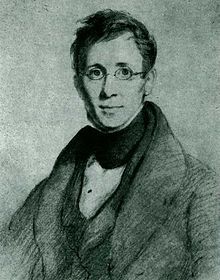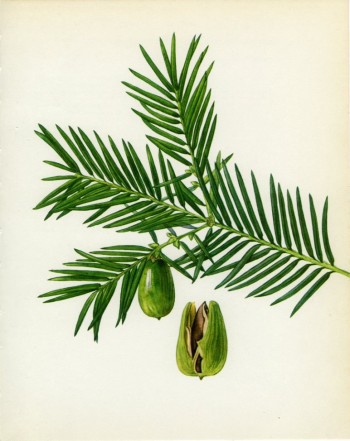Torreya as described in 1838 by George Arnott Walker Arnott (1799-1868), in Annals of Natural History ,1st edition, is a genus of conifers comprising six species in the Taxaceae family, formally sometimes placed in Cephalotaxaceae. The genus name honors celebrated American botanist John Torrey (1796-1873). Four species are native to eastern Asia; the other two are native to North America. Common names include nutmeg-yew, and stinking-cedar; and 榧'Š±ž (fei shu shu) in the Chinese language.
Description. Nutmeg-yews are small to medium-sized evergreen shrubs or trees that reach mature heights of 15 to 65 feet (5 - 20 m) tall, rarely to 80 feet (25 m).


The leaves are spirally arranged on the shoots, but twisted at the base to lie in two flat ranks; they are linear, 0.8 to 3.2 inches (2 - 8 cm) long and 0.12 to 0.16 inch (3 - 4 mm) broad, hard in texture, with a sharp spine tip.
Torreya can be either monoecious or dioecious; when monoecious, the male and female cones are often on different branches. The pollen cones (male fruiting structures) measure 0.2 to 0.32 inch (5 - 8 mm) long, arranged in lines along the underside of a shoot. The seed cones (female fruiting structures) are borne solitarye or in groups 2 to 8 together on a short stem. They are minute at first, maturing about 18 months after pollination to a drupe-like structure with a single, large, nut-like seed measuring 0.8 to 1.6 inches (2 - 4 cm) long surrounded by a fleshy covering, colored green to purple at full maturity.
In some species, notably the Japanese nutmeg-yew (Torreya nucifera), known locally as "kaya," the seeds are edible. Natural dispersal is thought to be aided by squirrels which bury the seeds for a winter food source. Any seeds left uneaten are then able to germinate.
California nutmeg-yew (Torreya californica) is endemic in California. It is the largest species of this genus, reaching heights of 80 feet (25 m) tall. One extinct species,
Florida nutmeg-yew or gopherwood (Torreya taxifolia) has a restricted habitat within Torreya State Park Florida, along the east bank of the Apalachicola River in the Florida Panhandle and immediately adjacent southernmost Georgia. Elvy E. Callaway, a lawyer who practiced in Bristol, Florida, claimed during his lifetime that it was the "gopher wood" used to build Noah's Ark. This conifer is a critically endangered species, which has suffered a major decline in numbers due to fungal disease (possibly Phytophthora), and post-glacial global warming. However, cultivated specimens are growing very well and regenerating naturally in cooler climates of northern Georgia and western North Carolina. Called "assisted migration", intentional movement of a plant outside of its historical range (though perhaps consistent with its deep-time range) became an important issue in the conservation community in 2007 and 2008, with T. taxifolia being the featured plant.
Paleobotany. Torreya clarnensis has been described from middle Eocene fossils found in the Clarno Formation of Central Oregon, United States. Leafy branch fossils of Torreya bilinica are known from Oligocene strata of Zichov near BÃlina, Czech Republic, early Miocene deposits of Güsvem central Anatolia, Turkey and late Miocene deposits of Spain. A single of Torreya nucifera needle leaf is known from a late Miocene deposit in Abkhazia. More complete records of Torreya nucifera are known from Pliocene deposits of France.